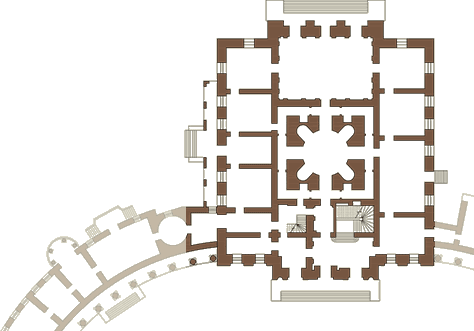The Corner Drawing Room
Загрузка панорамы...
A square corner room in the southwestern part of the ground floor of the palace. During its history, the interior has undergone several alterations. In 1784–1788, Charles Cameron arranged the Toilet Room and the Valet's Room of Grand Duchess Maria Feodorovna in this place. In 1798, Brenna partially changed the room, making a Venetian window on the south wall. In 1800, Quarenghi turned the room into the Emperor's bedchamber. Until the completion of the finishing of the Empress' apartments behind the Southern Gallery, it was here that Maria Feodorovna's widow's bedroom was. In 1816, Maria Feodorovna invited Carlo Rossi to the post of the architect of Pavlovsk and instructed him to turn the former bedroom into an elegant drawing room. So the Corner Drawing Room appeared. However, in 1855–1858, Ivan Potolov, the architect of Pavlovsk, at the request of Grand Duchess Alexandra Iosifovna, turned the room into a Boudoir in the style of the Rococo Revival, destroying the artificial marble decoration designed by Carlo Rossi in the process. The room was preserved in this state for the period from 1918, when the Palace became a museum, until September 1941, when Pavlovsk was in the occupation zone.
During the post-war restoration of the Palace, previously unknown documents about Carlo Rossi's activities in Pavlovsk were revealed. As a result of the extensive research work by N.I. Gromova, the chief curator of the palace back then and one of the creators of the methodology of scientific restoration, the decor by Carlo Rossi was returned to the interior. In 1960, Carlo Rossi's projects were found in the holdings of the Scientific Research Museum of the Academy of Arts, identified as corresponding with the plan of the Corner Drawing Room finishing. They were taken as the basis for the project of recreating the interior. Thus, almost 150 years later, the Corner Drawing Room, the first work of Carlo Rossi as the chief architect of Pavlovsk, was returned to its historical decoration. As per the plan of Carlo Rossi, the walls are divided into panels lined with artificial marble of lavender-lilac tones and decorated with ornamental murals imitating bronze. The plafond is also painted gridelin in the grisaille technique with classical masks. The draperies were recreated according to the discovered projects of Carlo Rossi, to be in harmony with the color scheme of the wall decoration. The curly birch doors were made from scratch. The drawing room is decorated with an authentic set of curly birch furniture made per the drawing by Carlo Rossi in the Saint Petersburg Bauman workshop. The upholstery is decorated with authentic Russian embroidery made with silk and wool on the canvas.
On the white marble fireplace, there is French bronze ware of the early 19th century: candelabra Mars and Minerva, clock Love Crowning Friendship, as well as vases of the Imperial Porcelain Factory with views of Yelagin Island. On the sides of the fireplace are two vases with picturesque scenes of Hector's Farewell to Andromache, based on scenes from Homer's Iliad (Imperial Porcelain Factory, the 1820s, painted by the artists of the factory S. Golov and V. Meshcheryakov).
In the study, there are tables characteristic of the furnishings of residential interiors of the time: an original corner table and a needlework table with a silk bag to store handiwork and threads. Near the sofa, there is a round decorative table on bronze legs with a tabletop of colored marble. The antique-style chandelier made of so-called amber glass with gilded bronze overlays was made in 1816 according to the project of Carlo Rossi for this interior.
Spectacular elements in the decoration of the living room against the background of windows with elegant draperies are the marble sculpture of Venus Italica (a copy from the work of Antonio Canova, the early 19th century) and a decorative vase of Revnev jasper (Kolyvan Lapidary Factory, 1849). Two years later, this vase, among other products of the factory, was exhibited at the Great Exhibition of the Works of Industry of All Nations in London.
The Corner Drawing Room on the floor plane
- The Raspberry Study
- The Common Study
- The New Study
- The Corner Drawing Room
- The White Dining Room
- The Billiards Room
- The Old Drawing Room
- The Ball Room
- The French Room
- The Dark Pantry

Back
